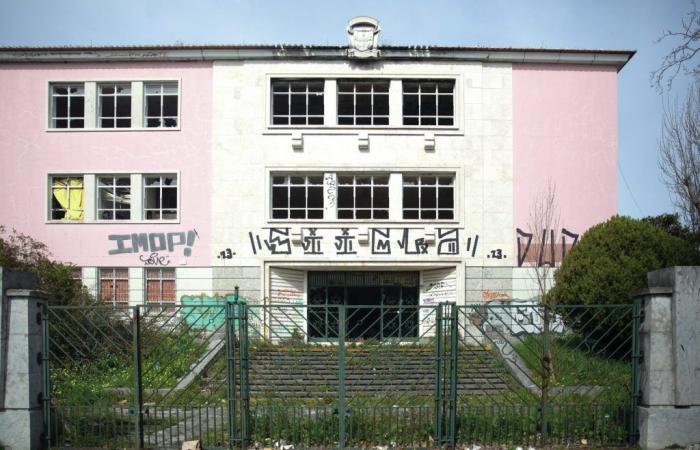If we write your name on one of those transport applications, it appears that it no longer exists. The truth is that it’s not easy to get here. «I had several friends who went to this school. I was always told very happy stories. The space is impressive, it’s really big. It’s sad to be abandoned. I will leave you, but I ask you to be careful. It is abandoned and several people ended up taking over the space. Be careful!”, warns the driver who takes us to the location. We are on Rua Miguel de Oliveira, at Escola Secundária Afonso Domingues, where for several years life took place behind the green gates that are now rusty, dilapidated and destroyed. It’s 2 pm and, despite it being the middle of March, the sun is burning, as if the peak of spring has already arrived. From time to time we see a person passing by who stops and observes with amazement the grandeur of this building, worn out by time and vandalized by those who have made it their home over these 14 years. The only life left in the space are the small flowers that, in unison, paint a colorful picture. The gate is open. As we enter the land we are immediately surprised by the rubbish that runs across the land and tries to cover the grass. Once inside the building, with the walls marked by graffiti, darkness and cold prevail, as if the past had been erased and abandoned.
From beginning to end
The Afonso Domingues Industrial School (EIAD) was founded in 1884 and moved here in 1956. During the Estado Novo, it was a reference in technical and professional education, in the areas of mechanics and electricity. At the time, it was known as «the university of Xabregas» due to its industrial courses, which were attended mainly by the children of master workers in the area. Before that, classes were taught in a rented house on Calçada do Grilo. Roughly three years later, it ended up moving to the ground floor of a mansion on Calçada da Cruz da Pedra, in the parish of São João. And, in 1897, it opened behind the Convento da Madre de Deus.
In 1948, it became known that the school would change location again, this time to Quinta das Veigas, in Marvila, today called Rua Miguel de Oliveira. The project, which was carried out by architect José Silva Costa, envisaged the construction of three buildings, with capacity for a thousand students, which would be distributed across 31 classes. The school reopened on October 1, 1956 and occupied a total area of approximately 20 thousand meters.
According to the Association of Residents and Entrepreneurs of Beato, the property and its street are on the list of properties of municipal interest and other immovable cultural assets. It closed its doors in 2010, by order of the Ministry of Education. The justification? The land was necessary for the construction of the Third Crossing over the Tagus (TTT), which would connect Chelas to Barreiro. And, above all, for the new TGV whose plan ended up not moving forward. Now, it appears that this will be demolished following the construction of a mega-urban development in Marvila. On 28 hectares – between Marvila and Beato –, according to Público, a new urban polarity will emerge, with a green park as the epicenter and direct connection to the river. Space will be needed for access to the TTT (hence the demolition of the school).
To the sadness of many
The signs of abandonment are more than clear. The environment is humid and terrifying. As we walk through the corridors, the sound of our footsteps echoes throughout the space. You can still see stickers in the shape of colorful feet on the ground as if showing us different paths. You can hear water dripping and, in the background, some voices and dogs barking, as if someone lived here. In every room we visit, we see shoes, mattresses, cushions, blankets, dirty clothes, plastic, empty tobacco packets, food remains and waste, both animal and human.
«I attended six years, from the 7th to the 12th year, at Escola Secundária Afonso Domingues, in Marvila», wrote João Pimentel Ferreira on his blog Vera Veritas, in 2013. According to him, after the 25th of April, the This school was attended by the children of the «rude, barbaric and illiterate bimbalhada, who came from the rural areas of the Viseu district to the factories in Lisbon, and who lived in the old Bairro Chinês, one of the largest clusters of shacks in Lisbon». However, he adds, it was also frequented by Portuguese-Africans who lived in the neighborhood of Zona J de Chelas, «who populated that area in the eighties, coming from the former colonies». «The pinch of salt was given by the gypsy community, who lived in social neighborhoods such as those in the old zone N and zone M of Chelas», he also recalls. However, according to the former student’s text, the school was not always this genetic-cultural ‘melting pot’. It had famous students such as the Nobel Prize-winning writer, José Saramago.
As the writer himself wrote in his biography on his foundation’s website, between 1935 and 1940, he took the Mechanical Metalwork course at this school, as his parents did not have the money for him to continue at high school. «The only alternative that was presented would be to enter a professional education school», the text reads. «The most surprising thing was that the school’s study plan, at that time, although obviously oriented towards technical professional training, included, in addition to French, a Literature subject», he revealed. «As I didn’t have any books at home (books of mine, bought by me, even with money lent by a friend, I was only able to have them when I was 19), it was Portuguese school books, due to their ‘anthological’ nature, that opened me up the doors to literary enjoyment», he continued. When he finished his course, Saramago worked for two years as a locksmith mechanic in a car repair shop.
Regarding the abandonment scenario that was already observed in 2013: «It is a mirror of the country we have! How is it that thousands of euros are spent on works, only to have a school closed later, because of the TGV project? And now that the TGV is not being built, how is it that the building is left abandoned to vandals and the poor? Could it not be reopened, as it is a school with excellent pavilions for teaching professional courses? Now the Government has even mentioned that it wants to implement the German model, in terms of teaching more specialized courses, an area in which this school was sublime?”, concluded João Pimentel Ferreira, who took the electronics and electricity course. And his sadness is shared by dozens of people who comment on his blog and who also leave testimony of their time at the same school. «I was also a student at EIAD from 1958 to 1963 and there I took Mechanics (daytime) and Industrial Designer (nighttime) courses», wrote three years later in the comments box, Manuel António Pires Abraços. «Later I continued my studies. I did a bachelor’s degree and a degree in engineering. I am very proud to say that EIAD was a solid foundation for my professional life as an engineer in companies and as a higher education teacher, particularly at ISEL. In fact, the entire succession of incomprehensible events that led to the closure of the Afonso Domingues Industrial School shocks me!”, he recalled. Furthermore, on Facebook, there is still a group of former Afonso Domingues students. Nascer do SOL tried to contact us, but received no response.
According to Público, the mega-urbanization in Marvila will be an operation of enormous impact and which – together with other urban projects planned for the surrounding area – «promises to revolutionize the eastern part of Lisbon». «The Marvila Execution Unit (UEM) involves the construction of a mega-urbanization, spread over an area of 28 hectares, with capacity for 1427 housing units, various equipment, a large green park and coverage of the Northern railway line over an extension of 400 meters, to facilitate access to the riverside area», wrote the same publication at the end of last month. As mentioned above, within this space, there will also be the construction of access to the Third Tagus Crossing (TTT) in Lisbon and the construction of new road access (mainly pedestrian and cycle paths). Thus, the building in which many lived the best years of their lives will disappear. All that will remain is the memory of what was one of the best-known industrial schools in the country.






